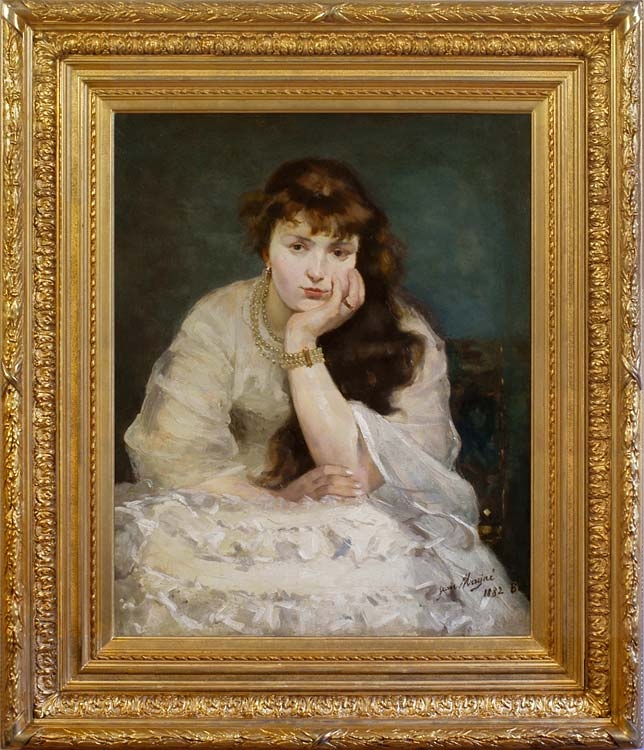Mayné’s work shows the influence of his teacher, Jean Portaels the orientalist, but remade in a northern European register. There are similarities to the elder painter’s work in Mayné’s orchestrating of graduated colour harmonies around a female figure, his portrayal of light on skin and pearls, and his use of a sponged, tonal background which renders the space ambiguous – either confined or infinite. The use of colour in this work is particularly successful, marrying the creamy tones of flesh and jewels with the diaphanous layers of the gauzy frock, and picking up the warm background greys in the shadows of frill and furbelow. It seems likely that Mayné was influenced by Whistler’s work (The white girl, 1861; The little white girl, 1865; Symphony in white, 1867), although it is not clear when he might have had the opportunity of seeing it.
Biographical details
Jean Mayné was born in 1854 into a family of artists in Bosvoorde, Belgium. His mother taught watercolour painting and his father was a technical draughtsman and cabinetmaker, in whose studio Jean first started his training. Later he moved to the private studio of Jean Portaels (1818-95), director of the Brussels Académie and an orientalist, and from 1873-79 he attended the Académie des Beaux-Arts in Brussels, in one year being placed higher than James Ensor in the final exams. He became a teacher himself in 1880, in the Académie d’Ixelles.
In 1881 he took part in the final exhibition of the progressive art movement, La Chrysalide, forerunner of Les XX, and members of which included Alfred Verhaeren, Victor Fontaine, and Auguste-Ernest Sembach (who had been in Portaels’s studio with Mayné). A couple of years later, he was one of the founder-members of the Brussels Cercle des Aquarellistes et des Aquafortistes Belges, and he also joined L’Essor, a group of alumni of the Académies des Beaux-Arts of Brussels, exhibiting with them from 1879-91. Amongst the members of the latter were Khnopff, Ensor and Théo Van Rysselberghe. When the Cercle of Aquarellistes fractured over disagreements to do with the quality of artists being admitted, Mayné joined the breakaway group, Les Hydrophiles, which flourished from 1884-89.
He painted portraits, genre scenes, and exotic subjects; and worked on the Panorama of Cairo. His oil paintings tend to be highly finished, but he also used pastels and pencils, in which his technique was much freer and more expressive.
He exhibited at the Salons of Paris and Antwerp, and in 1889 was awarded a bronze medal at the Exposition Universelle. In 1893 he had a solo exhibition at the Cercle Artistique in Brussels. He became a member of the executive committee of the Union des Artistes Ixellois in 1912, and in 1918 he showed at the Salon des Artistes Ixellois together with his daughter, Berthe Mayné.
Works in public collections include Tête de jeune oriental (Musée de Courtrai), and various works in the Musée d’Ixelles; Stedelijk Museum, Leuven; and Sint Bonifatiuskerk, Brussels.


